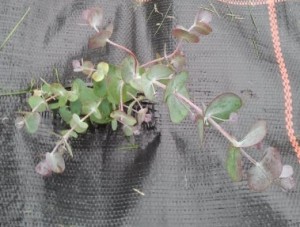Short rotation forestry – get the low down on Eucalyptus
The article below was first published in the October 2010 edition of Forestry and Timber news. For more information on the magazine click this link.
The Renewable Heat Incentive is certain to bring about a dash for biomass which is great news for boiler installers and woodland owners. The Forestry Commissions new Woodfuel Woodland Improvement Grant will initially help meet the burgeoning demand by increasing woodfuel production from undermanaged woodlands. But even with an extra 2 million tonnes of woodfuel there is still likely to be a significant shortfall in only a few years. Fast growing Eucalyptus species grown as short rotation forestry (SRF) could help meet the future gap. If planted in 2012, then plantations could be ready to harvest by the end of the decade.
Results from the FC’s SRF trials will not become available for several years. So in the mean time what should a prospective SRF grower consider before they commit themselves to this crop?
Variety choice
There are numerous species available and Eucalyptus nitens has the most eye catching yields – a trial planted in Kent by John Purse of Prima Bio yielded over 150 oven dry tonnes in eight years. The downside of this particular species is that it is one of the least hardy. The last two harsh winters have provided a stern test for recently established plantations and several novice plantations have been critically hit. You could dismiss this as a rare event but establishing Eucalyptus is expensive and in England there are no grants. Hence, it pays to weigh up the risk versus the reward and consider widening the species choice to include some good all rounders. For instance, E. glaucescens might yield around 30% less than E. nitens but is hardy to -16○C (4 degrees lower). It demonstrates excellent form and exceptional browsing resistance to deer and rabbits but has the added benefit of good coppicing ability.
Suitable sites
Most Eucalypts should do well on fertile well drained lowland soils such as sandy/clay loams and have a preference for neutral or slight acidity. SRF is suitable for grade 4-5 agricultural land but should also do well on forestry sites that have been clear felled due to Phytophora ramorum and red band needle blight outbreaks.
Establishment
Eucalyptus seedlings currently cost around £0.70 each plus delivery for bulk deliveries (2018 prices). Establishment costs can be reduced by planting at stocking rate of 2000-2500/ha but excellent weed control is critical in the first couple of years before canopy closure is achieved. Typically Eucalyptus plantations are fenced but this expense could be avoided by using browse resistant varieties.
To restock or coppice?
The coppicing ability of Eucalyptus is very important as it provides flexibility to growers. E. glaucescens and E. dalrympleana produce good coppice with 2-3 co-dominant stems but E. nitens and E. gunnii are less suitable for this option. The woodfuel quality of coppiced Eucalyptus will be slightly inferior due to the higher bark:wood ratio. In addition, the harvesting and extraction will be more involved and expensive. However, overall woodfuel production costs would be lowered by avoiding re-establishing the area.
Woodfuel quality
There is little information available to growers on the woodfuel characteristics of different Eucalyptus species. The received wisdom on the web suggests that Eucalyptus logs are quite difficult to split, dry well, burn fast without spitting and have a pleasant smell. Eucalyptus has a relatively low bulk density for a hardwood but more information is required for different species as this will impact on transport costs and storage requirements. Similarly, more analysis is required on the quality aspects of the woodfuel produced (e.g. ash %, ash melting point, chlorine content etc) as these factors will ultimately dictate the price paid by the consumer.
Potential income
The best current price available for supplying biomass to power stations is around £57/odt ex grower. With RPI running at around 4% it is possible to predict a price of £81/odt in 2020. With production costs of £52/odt and a modest yield of 104 odt over 8 years this would provide a profit (excluding interest rates) of £3016/ha or £377/year.
Better prices could be achieved by selling into heat markets. By generating your own customers e.g. a local school you could currently get an ex farm price of £85/odt or (£60/tonne at 30% MC). However, delivering the woodchip would require additional equipment and hassle so you might wish to sell direct to a woodfuel broker for a lower price. Of course, it would be a brave person who predicted the going rate for 8 years time but one hopes that prices will continue to rise with increased demand.
Grow your own options
Nevertheless, using your own woodchips is the real way to make money out of your crop. Oil at 60p/litre is equivalent to a heat price of 5.66p/kWh whereas using your own Eucalyptus woodchips with production costs of £52/odt would be around 1p/kWh. So you’ll make savings on the fuel and get RHI payments on top. A farm using 10,000 litres of heating oil per year (~100,000 kWh) in an old inefficient boiler would require about 27 tonnes (at 30% MC) of woodfuel per annum. This could be produced by growing 1.5-2 hectares of Eucalyptus planted in small blocks to allow for successive harvesting. Although, the crop will be ready to fell from year 8 onwards you could thin the crop after 4 years to keep the home fires burning.
Crops for Energy can assist land owners in making the right choices for woodfuel growing, supply and use through feasibility studies, turn key management options and training courses.
For more information call Crops for Energy on 0844 249 2901 or email kevin@crops4energy.co.uk
